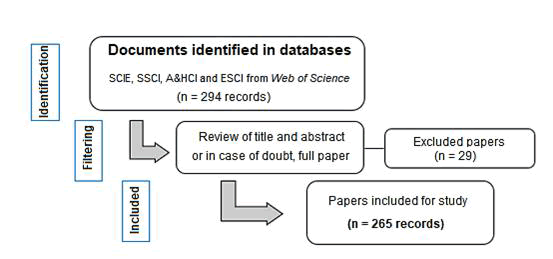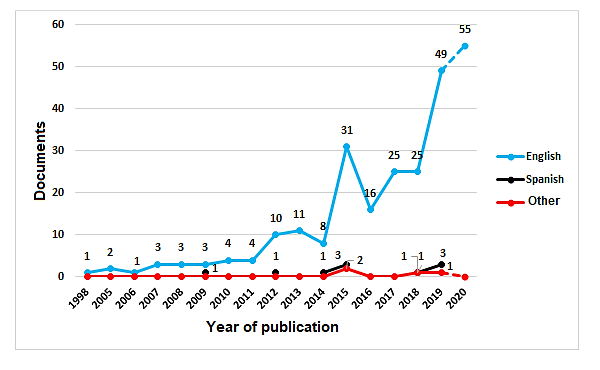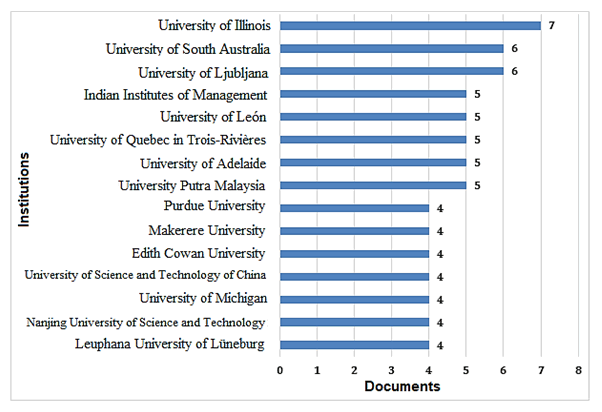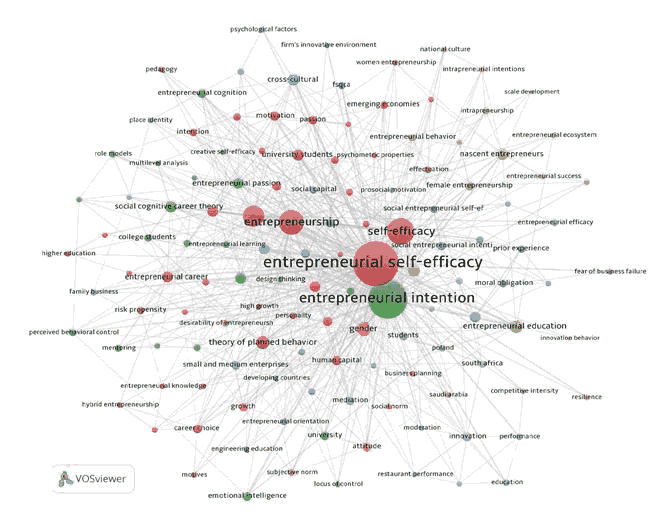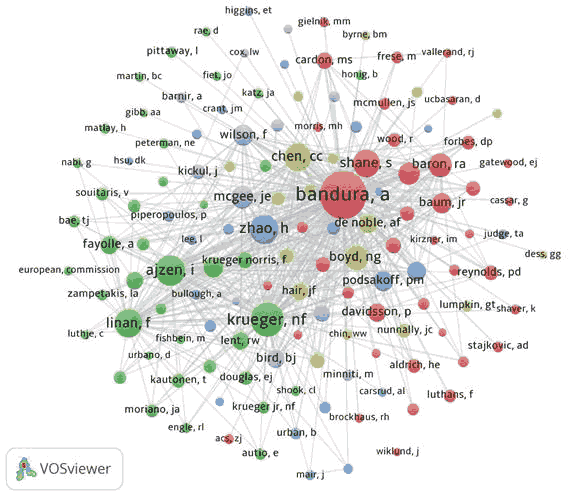Research Article: 2022 Vol: 21 Issue: 4
Entrepreneurial Self-efficacy. Bibliometric Aanalysis (1998-2020)
Diego Norena-Chavez, Pontificia Universidad Católica del Perú
Cesar H. Limaymanta, Universidad Nacional Mayor de San Marcos
Jose Luis Chumbe-Casas, Presidencia del Consejo de Ministros del Perú
Abstract
This research aimed to determine the behavior of the scientific literature on entrepreneurial self-efficacy. The bibliometric platform Web of Science Core Collection was used, which, after applying the search protocol, enabled the retrieval of records of scientific production on entrepreneurial self-efficacy (1998-2020). According to year, language, authors, institutions, and bibliometric networks of keyword co-occurrence and author co-citation to identify research trends and intellectual influence, respectively, production bibliometric indicators were analyzed. The analysis of the 265 documents revealed a trend of growth in scientific production during the period analyzed, with English as the predominant language over other languages. Hallak, Rob and Bagheri, Afsaneh stand out as the most productive authors. The University of Illinois, the University of South Australia, and the University of Ljubljana are some of the most productive institutions. The main topics related to entrepreneurial self-efficacy are entrepreneurial and business education, entrepreneurial intention, planned behavior, creativity, and the theory of planned behavior. Finally, Albert Bandura, Norris F. Krueger, and Icek Ajzen were identified as the most influential authors in the literature on entrepreneurial self-efficacy
Keywords
Entrepreneurial Self-Efficacy, Bibliometrics, Visualization Maps, Keyword Co-Occurrence, Co-Citation, Entrepreneurship, Entrepreneur
Introduction
Entrepreneurship is a crucial variable for public and private organizations' economic and sustainable growth (Muñoz & Cohen, 2018). Therefore, the capabilities of entrepreneurs are fundamental to raise the competitiveness of any country (Savickas et al., 2009). One of the key capabilities that any entrepreneur must have is entrepreneurial self-efficacy, defined by Bandura (1997) as the capacity of people to achieve goals by integrating cognitive, social, emotional, and behavioral competencies and organizing them to manage and achieve goals successfully. Also, entrepreneurial self-efficacy is a variant of self-efficacy that influences entrepreneurial motivation, intention, behavior, and performance (Newman et al., 2018). Entrepreneurial self-efficacy is supported by the social cognitive theory that relies on observation, social learning, and the environment to develop self-efficacy beliefs (Bandura, 1986).
Entrepreneurial self-efficacy is the strength of belief people must successfully perform specific roles and tasks related to entrepreneurship that determines an individual's degree of behavioral control and entrepreneurial intention (Chen, Greene & Cric, 1998; Krueger et al., 2000). In addition, entrepreneurial self-efficacy must be measured; there are currently six scales to measure this variable. The first was developed by Chen, et al., (1998) and consists of: a) six marketing items, b) four innovation items, c) five management items, d) four risk-taking items, and e) three control-taking items. The second was developed by DeNoble, et al., (1999). It consists of: a) seven items of new product and opportunity development, b) four items of innovative environment, c) three items of investor relations, d) three items of purpose definition, e) three items of facing unexpected challenges, and f) three items of human capital development. The third was developed by Zhao, et al., (2005) and consists of 4 global scale items. The fourth was developed by McGee, et al., (2009) and consists of: a) three search items, b) four planning items, c) three organization items, d) six implementation items, and e) three financing items. The fifth, developed by Barbosa, et al., (2007), consists of 18 items classified in the following dimensions: a) identification of opportunities, b) relationship development, c) management, and d) tolerance. Finally, the sixth, developed by Barakat, et al., (2014), consists of seven items classified in the following dimensions: a) financial value, b) teamwork, c) product development, d) new venture processes, e) innovation, f) leadership, and g) creativity.
On the other hand, entrepreneurial self-efficacy positively influences the following variables: a) the intention to start new businesses, b) the creation of new businesses, c) entrepreneurial actions, and d) entrepreneurial performance (Krueger et al., 2000; Moriano et al., 2012; Hechevarria et al., 2012; Tegtmeier et al., 2016; Cardon & Kirk, 2015; Newman et al., 2018; Trevelvan, 2011; Cassar & Friedman, 2009; Brinckmann & Kim, 2015). Some research concluded that entrepreneurial self-efficacy mediates and is mediated by the following variables: a) entrepreneurial passion, b) innovative behavior, c) founder passion, and d) entrepreneurial passion (Chen & He, 2011; Norena-Chavez, 2020; Dalborg & Wincent, 2015; Hong-Da et al., 2014; St Jean & Mathieu, 2015; Norena-Chavez & Guevara, 2020; Newman et al., 2019).
As for bibliometrics, Pritchard (1969) defined it as an instrumental discipline focused on studying science and the quantitative analysis of scientific production in its various categories of research, such as documents, authors, journals, institutions, countries, etc. From the early 21st century, bibliometric tools and indicators have increased due to the providers of bibliographic databases, which are combined with social network analysis and scientific mapping. This increase, supported by computerized methods and analysis programs, serves to describe, and evaluate the behavior of scientific production in different disciplines.
The only previous bibliometric study on entrepreneurial self-efficacy from Scopus is that of Marulanda-Valencia & Valencia-Arias (2019). They presented bibliometric indicators on journals, relevant authors, co-authorship network, number of publications per year, and trends in entrepreneurial self-efficacy. However, it is pertinent to extend the analysis from Web of Science to the most productive authors with their primary affiliations or, specifically, to analyze the most used keywords and the thematic structure within this field. In addition, it is essential to identify the intellectual influence (representative researchers) of the subject matter addressed through co-citation. Therefore, the purpose of this research was to analyze the behavior of the scientific literature on entrepreneurial self-efficacy in terms of production, thematic structure, and intellectual influence using a scientific mapping from 1998 to 2020 in the Web of Science Core Collection database to fill these gaps.
Methodology
This is a descriptive study with a bibliometric approach whose source of information was the databases Science Citation Index Expanded (SCIE), Social Sciences Citation Index (SSCI), Arts & Humanities Citation Index (A&HCI), and Emerging Sources Citation Index (ESCI) of the Web of Science Core Collection platform. They were selected because they facilitate data collection for bibliometric and scientometric studies. Information retrieval was done in September 2020 with the search equation: TS = ("entrepreneurial self-efficacy" OR (self-efficacy NEAR/1 "new venture") OR (self-efficacy NEAR/4 "startup") OR (self-efficacy NEAR/4 "new business") OR (self-efficacy NEAR/2 "new firm")), and the search terms with the highest thematic match were chosen, performing pilot tests with different closeness values and only articles and reviews were filtered. The period was from 1998 to 2020, since, in 1998, Chen et al. (1998) defined that entrepreneurial self-efficacy is a crucial piece distinguishing the entrepreneur from the manager. With this search strategy, 294 documents were retrieved. After the thematic verification, 265 final documents were found (Figure 1) since 29 papers whose research purposes were not focused on entrepreneurial self-efficacy issues were excluded. Finally, the records were downloaded in .txt format to analyze them with Excel 2019, Publish or Perish 7.0, Bibliometrix 3.0, and VOSviewer v1.6.15. Figure 1 explains the final record extraction sequence.
To analyze the intellectual influence and thematic structure of entrepreneurial self-efficacy, the software VOSviewer v1.6.15 (van Eck & Waltman, 2014) was used by making distance-based visualization maps after creating normalization thesauri for each of them. For elaborating these bibliometric maps or networks, the fractional counting method, recommended for this type of analysis, was used (Perianes-Rodríguez, Waltman & van Eck, 2016). One of the measurement attributes in the distribution of the nodes is the Total Link Strength (TLS), which is defined as the full strength of links of an item with other items (van Eck & Waltman, 2020). For example, in the keyword co-occurrence network, the attribute value indicates the total strength of co-occurrence links of a keyword with other keywords within the visualization map.
The bibliometric network includes nodes (units of analysis) and links (relationships). The units of analysis are the keywords for co-occurrence links, and the authors referenced or cited for co-citation links. The co-occurrence of keywords serves to identify the scientific structure of research fields and detect research fronts from cluster formation (White & Mccain, 1998; Fujita et al., 2014; Gregorio-Chaviano et al., 2020). For its part, co-citation is a measure of similarity or relatedness between units of analysis using direct citation relationships and is defined as the frequency with which two documents are co-cited by other documents (Small, 1973; Wang et al., 2016). Author Co-occurrence Analysis (ACA) as a technique to identify the intellectual structure of scientific disciplines occurs when two items (authors B and C in this case) are quoted by a third item (author A) in their work (White & Griffith, 1981; Zhao & Strotmann, 2008). On the one hand, this article shows the keyword co-occurrence analysis to identify the most representative topics related to entrepreneurial self-efficacy. The ACA is also used to determine the structure of intellectual influences, i.e., the authors quoted in the bibliographic references as first author (van Eck & Waltman, 2020), who have influenced the authors who published the analyzed documents.
Results
Evolution of the Scientific Production on Entrepreneurial Self-Efficacy
Figure 2 shows the number of papers published from 1998 to 2020, according to the publication language. We can see that there was little scientific production on entrepreneurial self-efficacy from 1998 - 2011. Then, a slight increase took place until 2015, with a decrease in 2016. However, since 2016, there has been a considerable increase; even 2020 has not yet ended and shows sustainable growth. It shows the predominance of English as the language of publication with 251 records (94.7 %), followed by Spanish with ten records (3.8 %) and other languages with four records (1.5 %).
Most Productive Authors
Table 1 shows the 22 most productive authors of entrepreneurial self-efficacy, the institution to which they belong, the country, and the Web of Science H-index. Authors who have contributed more than four papers to date include Hallak R from the University of South Australia and Bagheri, A. from the University of Tehran.
| Table 1 Most Productive Authors of Entrepreneurial Self-Efficacy |
||||
|---|---|---|---|---|
| Author | Documents | Institution | Country | WoS H-index |
| Hallak, Rob | 6 | University of South Australia | Australia | 13 |
| Bagheri, Afsaneh | 5 | University of Tehran | Iran | 8 |
| Haddoud, Mohamed Yacine | 4 | University of Plymouth | England | 6 |
| Lee, Craig | 4 | University of Otago Business School | New Zealand | 4 |
| Sieger, Philipp | 4 | University of Bern | Switzerland | 12 |
| St-jean, Etienne | 4 | University of Quebec in Trois-Rivières | Canada | 8 |
| Pihie, Zaidatol Akmaliah Lope | 4 | University Putra Malaysia | Malaysia | 8 |
| Urban, Boris | 4 | University of the Witwatersrand | South Africa | 3 |
| Caetano, Antonio | 3 | University Institute of Lisbon | Portugal | 13 |
| Cardon, Melissa | 3 | University of Tennessee | United States | 20 |
| Moriano, Juan Antonio | 3 | University of Barcelona | Spain | 17 |
| Gielnik, Michael | 3 | Leuphana University of Lüneburg | German | 14 |
| Vazquez, Jose Luis | 3 | University of León | Spain | 5 |
| Zhou, Xiaohu | 3 | University of Hong Kong | China | 15 |
| Lanero, Ana | 3 | University of León | Spain | 5 |
| Nowinski, Witold | 3 | WSB University | Poland | 2 |
| Renko, Maija | 3 | DePaul University | United States | 16 |
| Santos, Susana | 3 | Rowan University | United States | 8 |
| Sardeshmukh, Shruti | 3 | University of South Australia | Australia | 10 |
| Shekhar, Prateek | 3 | New Jersey Institute of Technology | United States | 5 |
| Wincent, Joakim | 3 | University of St. Gallen | Switzerland | 27 |
| Wu, Wenqing | 3 | Southwest University of Science and Technology | China | 22 |
Most Productive Universities
Figure 3 shows the ranking of the 15 organizations with the highest scientific production on entrepreneurial self-efficacy. Top-producing universities include the University of Illinois with seven records and the University of South Australia and the University of Ljubljana, both with six records.
Keyword Co-Occurrence MapFigure 4 shows the visualization of the keyword co-occurrence map. Each circle (node) represents a keyword, and its size indicates the number of publications that have that keyword in the document. Out of 531 keywords, the map shows 130 with at least two occurrences. VOS viewer has grouped the keywords into nine clusters; however, in Table II, the seven clusters with the highest frequency of occurrences are presented. The five words with the highest occurrence include: a) entrepreneurial self-efficacy, b) entrepreneurial self-efficacy, c) self-efficacy, d) entrepreneurship, and e) entrepreneurial intention. These words are most related to entrepreneurial self-efficacy, as they either influence or are influenced by this variable.
Figure 4: Map of Keyword Co-Occurrence
Note: Keywords with at least 2 occurrences. Out of 531 keywords, 130 meet the threshold.
| Table 2 Clusters and Frequency of Occurrence |
||
|---|---|---|
| Cluster | Keyword | Times |
| 1 Red | Entrepreneurial Self-Efficacy | 127 |
| Self-Efficacy | 45 | |
| Entrepreneurship | 39 | |
| Entrepreneurial education | 30 | |
| Theory of planned behavior | 11 | |
| 2 Green | Entrepreneurial intention | 94 |
| Social cognitive theory program | 8 | |
| Entrepreneurial passion | 7 | |
| Opportunity recognition | 7 | |
| Emotional Intelligence | 5 | |
| 3 Blue | Empathy | 7 |
| Social entrepreneurship | 6 | |
| Self-employment | 5 | |
| Social Entrepreneurship Intention | 5 | |
| Moral Obligation | 4 | |
| 4 Yellow | Business education | 11 |
| Creativity | 9 | |
| Emerging entrepreneurs | 8 | |
| Female entrepreneurship | 5 | |
| Entrepreneurial behavior | 5 | |
| 5 Purple | Innovation | 6 |
| Students | 5 | |
| Southern Africa | 4 | |
| Education | 3 | |
| Entrepreneurial alertness | 3 | |
| 6 Light blue | Cross-cultural | 9 |
| Structural Equation Modeling | 7 | |
| Mediation | 5 | |
| Small and medium enterprises | 5 | |
| Entrepreneurial effectiveness | 3 | |
| 7 Orange | Gender | 13 |
| Attitude | 5 | |
| Growth | 5 | |
| Desire for entrepreneurship | 3 | |
| Subjective norms | 3 | |
Author Co-Citation Analysis (ACA)
Using the ACA bibliometric network, six clusters were identified, grouping the 135 authors (including researchers and institutions such as the European Commission) with the most significant intellectual influence in the documents analyzed (Figure 5). The circle size represents the co-citation strength of the authors, as measured by the FTE obtained with the VOSviewer software. Bandura, A. in the red cluster and Krueger, N. F. in the green cluster are observed as the two most representative authors with 497.9 and 260.9 FTE, respectively. Among his significant contributions, Bandura (1986) concluded that entrepreneurial self-efficacy originates from social cognitive theory, emphasizing the role of the environment, observation, and behavioral collection in social learning to develop self-efficacy beliefs. Krueger, et al., (2000) concluded that entrepreneurial self-efficacy captures the degree of behavioral control perceived by an individual that is determinant at the time of entrepreneurship.
On the other hand, Ajzen (1991) defined the theory of planned behavior that groups variables such as attitude, subjective norms, perceived behavioral control, which are the basis of entrepreneurial self-efficacy. Entrepreneurial self-efficacy refers to an individual's belief in his or her ability to perform entrepreneurial outcome-oriented tasks and roles (Chen et al., 1998). Zhao's (2005) contribution was developing a four-item scale to measure an individual's self-efficacy concerning specific entrepreneurial situations. Shane & Venkataraman (2000) defined entrepreneurship as the process of co-creating, evaluating, and exploiting opportunities to produce goods and services.
Table 3 shows the distribution of the top 10 authors with the highest FTE of co-citation in the scientific literature on entrepreneurial self-efficacy. These are the top seminal authors who have an intellectual influence on the subject matter under study. Each author was identified with his or her affiliation, country of location, email address, number of quotes in the dataset, and co-citation FTE. A particular phenomenon observed is that nine of the ten researchers belong to U.S. institutions, and only one author belongs to a Spanish institution. This shows the significant influence that Anglo-Saxon authors have had, and still have, on the scientific literature on entrepreneurial self-efficacy.
Clusters represented in the top 10 are red, green, blue, yellow, and purple. In general, authors that are close to each other in the visualization map are more closely related according to the co-citation strength of the authors. Although authors located far from each other are less closely related, this does not imply that the citators have consciously judged them to be different. It may simply mean that they have not yet perceived the possible relationships between their works (such as those of Liñán, Francisco and Baron, Robert), and this situation may change over time.
| Table 3 Top 10 Authors With The Highest Citation FTE |
|||||
|---|---|---|---|---|---|
| No | Author | Email/Google scholar | NC | FTE | Institution/Country |
| 1 | Bandura, Albert. (Red) | https://scholar.google.com/citations?hl=es&user=muejNL8AAAAJ | 542 | 497.9 | Stanford University /USA |
| 2 | Krueger, Norris F. (Green) | https://research.phoenix.edu/users/norris-krueger | 276 | 260.9 | University of Phoenix /USA |
| 3 | Ajzen, Icek. (Green) | https://people.umass.edu/aizen/index.html | 220 | 212.3 | University of Massachusetts Amherst /USA |
| 4 | Zhao, Hao. (Blue) | https://scholar.google.com/citations?user=QQdpgpsAAAAJ&hl=es | 201 | 198.5 | Rensselaer Polytechnic institute/USA |
| 5 | Liñán, Francisco. (Green) | https://scholar.google.com/citations?hl=es&user=oNUXi0UAAAAJ&view_op=list_works&sortby=pubdate | 192 | 183.3 | University of Seville/Spain |
| 6 | Chen, Chao C. (Yellow) | https://scholar.google.com.pe/citations?user=NPkHPEEAAAAJ&hl=es&oi=sra | 176 | 176 | Rutgers University/USA |
| 7 | Shane, Scott (Red) | https://smallbiztrends.com/author/scott-shane | 178 | 173.1 | Case Western Reserve University/USA |
| 8 | Boyd, Nancy G. (Yellow) | https://journals.sagepub.com/action/doSearch?target=default&ContribAuthorStored=Boyd%2C+Nancy+G | 134 | 133.9 | University of North Texas/USA |
| 9 | Baron, Robert A. (Red) | https://scholar.google.com.pe/citations?user=O46yySwAAAAJ&hl=es&oi=sra | 138 | 131.7 | Oklahoma State University /USA |
| 10 | McGee, Jeffrey E. (Purple) | https://scholar.google.com/citations?user=jjsSMpAAAAAJ&hl=es | 127 | 126.5 | University of Texas at Arlington /USA |
| Note: NC = number of citations in the data set, FTE = total link strength | |||||
Discussion and Conclusion
This research was achieved through a bibliometric analysis. In this way, this article contributed to the entrepreneurial self-efficacy literature through a review of 264 refereed papers (1998-2020).
Based on the results, the scientific production on entrepreneurial self-efficacy has shown sustained growth during the study period, with a fluctuation between 2015 and 2017. This result coincides with the conclusions of Valencia-Arias & Marulanda-Valencia (2019). This growth trend reveals the importance of this topic since it is researched by authors from different parts of the world whose organizations are mainly universities, such as the University of Illinois in the United States, the University of León in Spain. Likewise, 94.7% of the documents were published in English, far superior to other languages. In last century's studies, such as Price's (1986), the same phenomenon was already evident. Hallak, Rob (6 papers), from the University of South Australia, Australia, and Bagheri, Afsaneh (5 papers), from the University of Tehran, Iran, stand out as the most productive authors. The most productive institutions included the University of Illinois, with seven papers, the University of South Australia, and the University of Ljubljana, both with six papers on this topic.
The keyword co-occurrence map allowed identifying the thematic structure of entrepreneurial self-efficacy by nine clusters that clarified the topic's different approaches and research trends. The main topics related to entrepreneurial self-efficacy are entrepreneurial and business education, entrepreneurial intention, planned behavior, creativity, theory of planned behavior, emerging entrepreneurship, empathy, etc. Based on these topics, future lines of research are suggested, among which education and entrepreneurial intention stand out as key elements within entrepreneurial self-efficacy.
By analyzing bibliometric network visualization maps based on author-citation links, it was possible to identify the intellectual influence of entrepreneurial self-efficacy, i.e., the most influential seminal researchers and authors in entrepreneurial self-efficacy papers based on their bibliographic references. Among them, Bandura, Albert, Stanford University, USA, was identified as the most influential, which coincides with Valencia-Arias & Marulanda-Valencia (2019). Other influential intellectuals are Krueger, Norris F., University of Phoenix, USA, and Ajzen, Icek, University of Massachusetts Amherst, USA, authors with higher FTE of co-citation. The only Ibero-American influential author in the top 10 with the highest FTE is Liñán, Francisco, from the University of Seville, Spain.
These quantitative results based on bibliometric techniques allowed us to identify the temporary evaluation of the topic, the languages of publication, the most productive authors with their affiliations, and H-index, the most productive universities, the topics being researched in entrepreneurial self-efficacy, and the intellectual influence through co-citation. This provides a clear picture of the scientific production of entrepreneurial self-efficacy. However, future studies on entrepreneurial self-efficacy can complement these results with qualitative analyses of narrative reviews, systematic reviews, and meta-analyses.
From this study, two directions are suggested. First, entrepreneurs should consider variables such as entrepreneurial self-efficacy to increase the probability of success in their businesses. Finally, it is recommended that future studies analyze the topic addressed through collaboration indicators and networks, impact indicators, network analysis, among other metrics, which will complement the results of this study. Likewise, other sources of information such as Scopus, Dimensions, Microsoft Academic, Lens, etc., can be extended to broaden the coverage of scientific production on entrepreneurial self-efficacy.
References
Ajzen, I. (1991). The theory of planned behavior. Organizational behavior and human decision processes, 50(2), 179-211.
Bandura, A. (1986). Social foundations of thought and action: A social cognitive theory. Englewood Cliffs, NJ, Prentice-Hall.
Bandura, A. (1997). Self-efficacy: The exercise of control. New York: Freeman.
Barakat, S., Boddington, M., & Vyakarnam, S. (2014). Measuring entrepreneurial self-efficacy to understand the impact of creative activities for learning innovation. The International Journal of Management Education, 12, 456–468. https://doi.org/10.1016/j.ijme.2014.05.007
Semantic scholar, Crossref, Google scholar
Barbosa, S., Gerhardt, M., & Kickul, J. (2007). The role of cognitive style and risk preference on entrepreneurial self-efficacy and entrepreneurial intentions. Journal of Leadership and Organizational Studies, 13, 86–04.
Brinckmann, J., & Kim, S. (2015). Why we plan: The impact of nascent entrepreneurs' cognitive characteristics and human capital on business planning. Strategic Entrepreneurship Journal, 9, 153–166.
Cardon, M., & Kirk, C. (2015). Entrepreneurial passion as mediator of the self-efficacy to persistence relationship. Entrepreneurship: Theory and Practice, 39(5), 1027-1050.
Semantic scholar, Crossref, Google scholar
Cassar, G., & Friedman, H. (2009). Does self-efficacy affect entrepreneurial investment? Strategic Entrepreneurship Journal, 3, 241–260.
Semantic scholar, Crossref, Google scholar
Chen, C.C., Greene, P.G., & Crick, A. (1998). Does entrepreneurial self-efficacy distinguish entrepreneurs from managers? Journal of Business Venturing, 13(4), 295–316.
Semantic scholar, Crossref, Google scholar
Chen, Y., & He, Y. (2011). The impact of strong ties on entrepreneurial intention: An empirical study based on the mediating role of self-efficacy. Journal of Chinese Entrepreneurship, 3(2), 147–158.
Dalborg, C., & Wincent, J. (2015). The idea is not enough: The role of self-efficacy in mediating the relationship between pull entrepreneurship and founder passion–A research note. International Small Business Journal, 33, 974–984.
De Noble, A.F., Jung, D., & Ehrlich, S. (1999). Entrepreneurial self-efficacy: The development of a measure and its relationship to entrepreneurial action. Frontiers of entrepreneurship research, 1, 73-87.
Fujita, K., Kajikawa, Y., Mori, J., & Sakata, I. (2014). Detecting research fronts using different types of weighted citation networks. Journal of Engineering and Technology Management - JET-M, 32, 129–146.
Semantic scholar, Crossref, Google scholar
Gregorio-Chaviano, O., Limaymanta, C.H., & López-Mesa, E.K. (2020). Bibliometric analysis of the Latin American scientific production on COVID-19. Biomedical, 40(Supl. 2).
Hechevarria, D., Renko, M., & Matthews, C. (2012). The nascent entrepreneurship hub: Goals, entrepreneurial self-efficacy and start-up outcomes. Small Business Economics, 39, 685–701.
Hong-Da, L., Chun-His, C., Chin-Tien, H., & Wu-Chen, F. (2014). Relationship between entrepreneurial leadership and innovative behavior: The mediating effect of entrepreneurial self-efficacy and the moderating effect of openness to experience and extraversion. Information Technology Journal, 13, 1035-1044. https://doi.org/ 10.3923/itj.2014.1035.1044
Krueger, N., Reilly, M., & Carsrud, A. (2000). Competing models of entrepreneurial intentions. Journal of Business Venturing, 15(5/6), 411–432. https://doi.org/10.1016/S0883-9026(98)00033-0
Marulanda-Valencia, F., Ángela, & Valencia-Arias, J.A. (2019). Evolution and research trends in entrepreneurial self-efficacy: A bibliometric analysis. Management Studies, 35(151).
McGee, J., & Peterson, M. (2017). The long-term impact of entrepreneurial self-efficacy and entrepreneurial orientation on venture performance. Journal of Small Business Management.
Semantic scholar, Crossref, Google scholar
Moriano, J., Gorgievski, M., Laguna, M., Stephan, U., & Zarafshani, K. (2012). A cross-cultural approach to understanding entrepreneurial intention. Journal of Career Development, 39(2), 162–185.
Muñoz, P., & Cohen, B. (2018). Sustainable entrepreneurship research: Taking stock and looking ahead. Business Strategy and the Environment, 27, 300e322.
Semantic scholar, Crossref, Google scholar
Newman, A., Tse, H.H.M., Schwarz, G., & Nielsen, I. (2018). The effects of employees’ creative self-efficacy on innovative behavior: The role of entrepreneurial leadership. Journal of Business Research, 89, 1-9.
Semantic scholar, Crossref, Google scholar
Newman, A., Obschonka, M., Schwarz, S., Cohen, M., & Nielsen, I. (2019). Entrepreneurial self-efficacy: A systematic review of the literature on its theoretical foundations, measurement, antecedents, and outcomes, and an agenda for future research. Journal of Vocational Behavior, 110, 403-419.
Semantic scholar, Crossref, Google scholar
Norena-Chavez, D.A., & Guevara, R. (2020). Entrepreneurial passion and self-efficacy as factors explaining innovative behavior: A mediation model. International Journal of Economics and Business Administration, 8(3), 352-373.
Semantic scholar, Crossref, Google scholar
Norena-Chavez, D. (2020). The mediation effect of innovative behavior on the relationship between entrepreneurial self-efficacy and entrepreneurial intention. International Journal of Economics and Business Administration, 8(4), 238-252.
Perianes-Rodríguez, A., Waltman, L., & Van Eck, N.J. (2016). Constructing bibliometric networks: A comparison between full and fractional counting. En Journal of Informetrics, 10(4), 1178–1195.
Semantic scholar, Crossref, Google scholar
Price, D.J.S. (1986). Little Science, big science...and beyond. New York: Columbia University Press.
Pritchard, A. (1969). Statistical bibliography or bibliometrics. Journal of documentation, 25(4), 348-349.
Semantic scholar, Google scholar
Savickas, M., Nota, L., Rossier, J., Dauwalder, J., Duarte, M., Guichard, J., & Van Vianen, A. (2009). Life designing: A paradigm for career construction in the 21st century. Journal of Vocational Behavior, 75(3), 239–250.
Semantic scholar, Crossref, Google scholar
Shane, S., & Venkataraman, S. (2000). The promise of entrepreneurship as a field of research. Academy of Management Review, 25, 217-226.
Semantic scholar, Crossref, Google scholar
Small, H. (1973). Co-citation in the scientific literature: A new measure of the relationship between two documents. Journal of the American Society for Information Science, 24(4), 265–269.
Semantic scholar, Crossref, Google scholar
St-Jean, É., & Mathieu, C. (2015). Developing attitudes toward an entrepreneurial career through mentoring: The mediating role of entrepreneurial self-efficacy. Journal of Career Development, 42(4), 325-338.
Tegtmeier, S., Kurczewska, A., & Halberstadt, J. (2016). Are women graduates jacquelines-of-all-trades? Challenging Lazear's view on entrepreneurship. Small Business Economics, 47, 77–94. https://doi.org/10.1007_s11187-016-9727-8
Semantic scholar, Crossref, Google scholar
Trevelyan, R. (2011). Self-efficacy and effort in new venture development. Journal of Management & Organization, 17, 2–16.
Valencia-Arias, J.A., & Marulanda-Valencia, F.Á. (2019). Evolution and research trends in entrepreneurial self-efficacy: A bibliometric análisis. Estudios Gerenciales, 35(151), 219-232.
van Eck, N.J., & Waltman, L. (2014). Visualizing bibliometric networks. En Y. Ding, R. Rousseau, & D. Wolfram (Eds.), Measuring Schollarly impact, pp. 285–320. Switzerland: Springer Berlin Heidelberg.
Semantic scholar, Crossref, Google scholar
van Eck N.J., Waltman L. (2020). VOSviewer Manual. Universiteit Leiden, CWTS Meaningful metrics; Recuperado de: https://www.vosviewer.com/getting-started
Wang, Y., Lai, N., Zuo, J., Chen, G., & Du, H. (2016). Characteristics and trends of research on waste-to-energy incineration: A bibliometric analysis, 1999–2015. Renewable and Sustainable Energy Reviews, 66, 95–104.
White, H.D., & Griffith, B.C. (1981). Author cocitation: A literature measure of intellectual structure. En Journal of the American Society for Information Science, 32(3), 163-171.
Semantic scholar, Crossref, Google scholar
White, H.D., & Mccain, K.W. (1998). Visualizing a Discipline: An author co-citation analysis of information science, 1972 – 1995. Society, 49(4), 327–355.
Semantic scholar, Crossref, Google scholar
Zhao, D., & Strotmann, A. (2008). Evolution of research activities and intellectual influences in information science 1996–2005: Introducing author bibliographic-coupling analysis. En Journal of the American Society for Information Science and Technology, 59(13), 2070–2086.
Semantic scholar, Crossref, Google scholar
Zhao, H., Seibert, S., & Hills, G. (2005). The mediating role of self-efficacy in the development of entrepreneurial intentions. Journal of Applied Psychology, 90,
1265–1272.
